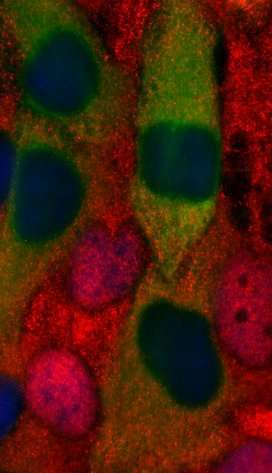STAT2: Much more than an antiviral protein

A protein known for guarding against viral infections leads a double life, new research shows, and can interfere with cell growth and the defense against parasites. In a new paper publishing 25 October in the open-access journal PLOS Biology, Johnathan Ho and Uwe Vinkemeier at the University of Nottingham, UK, and colleagues describe the duplicitous nature of this essential protein, called STAT2, which they discovered while investigating the mechanisms behind interferon signaling.
Interferons are powerful antimicrobials that can also stop the proliferation of normal and cancer cells. Since their discovery in the early 1950s, intense research into the modus operandi of these molecules culminated 25 years ago, when it was found that interferon requires STAT2 and a closely related partner protein, STAT1, to function. This paradigm has been consistently validated and refined over the last decades. While STAT1 has since been assigned multiple additional roles, STAT2 was thought to function primarily as the partner of STAT1 in interferon signaling. The work published in PLOS Biology reveals an entirely novel aspect of STAT2 as an inhibitor of STAT1, extending its reach far beyond interferon and antiviral immunity.
"It's astounding to see such robust antagonistic behavior between two proteins so classically associated with co-operation," says graduate student Johnathan Ho, the paper's first author.
This new research uncovers the molecular mechanism of STAT2's two-faced nature, alongside the development of novel tools that can disarm its enabling and inhibitory behaviors. These new tools make it possible to study previously inaccessible features of STAT2 functioning such as regulation of cellular growth and ageing, blood poisoning and infectious diseases. Moreover, although interferon therapies have proven indispensable for treating a wide range of ailments like viral hepatitis, multiple sclerosis and cancers, their application is hindered by serious adverse effects and unpredictable therapeutic outcomes. The insights offered by this work will be key to overcoming such limitations.
More information: Ho J, Pelzel C, Begitt A, Mee M, Elsheikha HM, Scott DJ, et al. (2016) STAT2 Is a Pervasive Cytokine Regulator due to Its Inhibition of STAT1 in Multiple Signaling Pathways. PLoS Biol 14(10): e2000117. DOI: 10.1371/journal.pbio.2000117
Journal information: PLoS Biology
Provided by Public Library of Science















